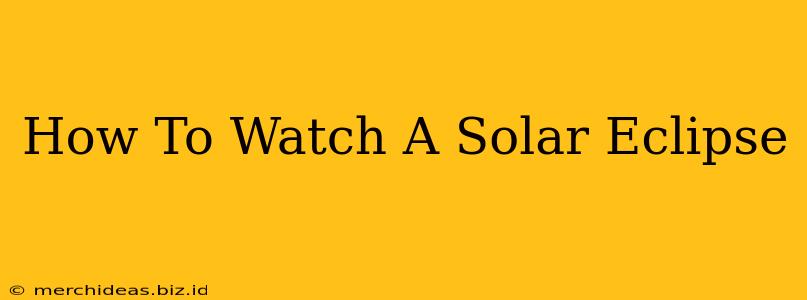Witnessing a solar eclipse is a truly awe-inspiring experience, but it's crucial to prioritize eye safety. Looking directly at the sun, even during a partial eclipse, can cause serious and permanent eye damage. This guide explains how to watch a solar eclipse safely and enjoyably, ensuring you create unforgettable memories without risking your eyesight.
Understanding the Dangers of Direct Sun Exposure
The sun's intense radiation can severely damage your retina, the light-sensitive tissue at the back of your eye. This damage can lead to solar retinopathy, a condition that may cause blurred vision, blind spots, and even complete vision loss. Never look directly at the sun without proper eye protection, even if the sun appears partially obscured during an eclipse.
Why Special Eye Protection is Necessary
Regular sunglasses, even very dark ones, are not sufficient to protect your eyes from the sun's harmful rays during a solar eclipse. They simply aren't designed to filter out the specific wavelengths of light that can cause solar retinopathy. You need specialized solar filters designed for safe solar viewing.
Safe Solar Eclipse Viewing Methods
Several safe methods allow you to witness this celestial event without risking your vision:
1. Solar Eclipse Glasses (ISO 12312-2 certified)
ISO 12312-2 certified solar eclipse glasses are the most common and readily available method. These glasses are specifically designed to block harmful ultraviolet (UV) and infrared (IR) radiation, allowing only a tiny fraction of visible light to pass through. Ensure your glasses meet this safety standard – look for the ISO 12312-2 certification printed on the glasses.
Important Considerations:
- Check the glasses for any scratches or damage before use. Damaged glasses offer reduced protection.
- Supervise children carefully while they are wearing the glasses.
- Never look at the sun through these glasses without putting them on.
2. Solar Viewers (with ISO 12312-2 certification)
Similar to glasses, handheld solar viewers offer another safe way to view the eclipse. These are often small cardboard boxes with a pinhole opening and a solar filter. Again, ensure they meet the ISO 12312-2 standard.
3. Indirect Viewing Methods – Pinhole Projection
A safe and inexpensive alternative to specialized eyewear involves creating a pinhole projector. This method projects the image of the sun onto a surface, eliminating the need to look directly at the sun.
How to Make a Pinhole Projector:
- Poke a small hole (about the size of a pinprick) in a piece of cardboard.
- Hold the cardboard up to the sun, letting the sunlight shine through the hole.
- Project the sun's image onto a white surface (a wall or piece of paper) behind the cardboard. You'll see a projected image of the sun, showing the eclipse progress.
4. Watching the Eclipse Online
Many organizations will broadcast the eclipse live online. This allows you to view the spectacle safely and comfortably from the comfort of your own home.
Planning for Your Eclipse Viewing
Before the event:
- Purchase your ISO 12312-2 certified eclipse glasses or viewers well in advance. Demand for these increases sharply as the eclipse approaches, leading to potential shortages.
- Find a good viewing location. Consider factors such as weather conditions and the degree of the eclipse.
- Check the eclipse timing for your location. Know when the partial eclipse begins, when totality (if visible) occurs, and when the eclipse ends.
By following these safety precautions and enjoying the indirect viewing methods, you can enjoy the majestic spectacle of a solar eclipse without putting your eyesight at risk. Remember, your vision is priceless!
